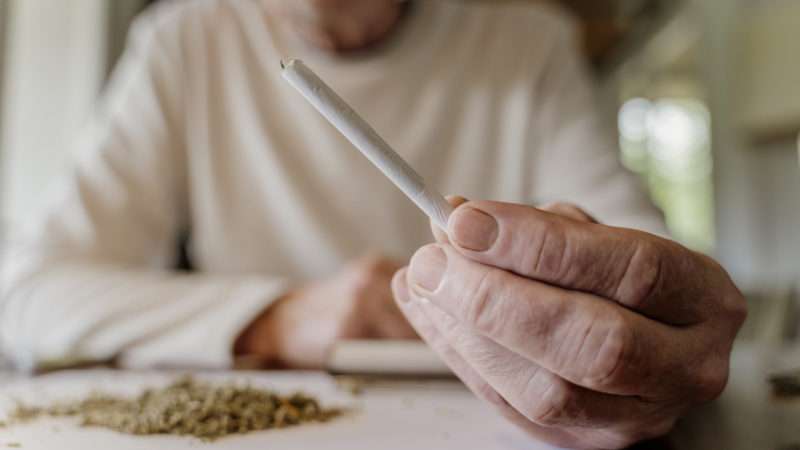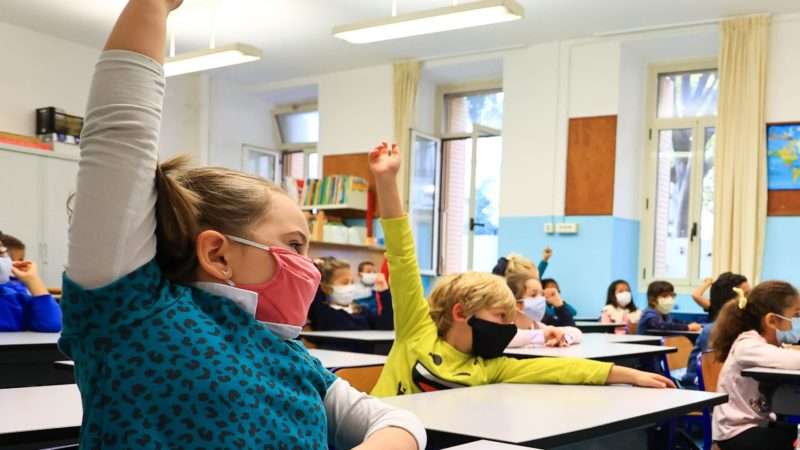As newly detected COVID-19 infections in France spiraled toward 40,000 a day—almost three times the U.S. rate in per capita terms—President Emmanuel Macron announced that his country would undertake a second national lockdown, starting last Friday. But there was one big difference from France’s last lockdown: This time, the schools would remain open.
It’s a sharp contrast with large parts of the U.S., where there has been substantial resistance to reopening schools. Teachers unions in affluent Fairfax, Virginia, recently petitioned for the district’s schools to remain closed for the entire 2020–21 school year. Last week, hundreds of teachers held a sick-out in Idaho’s largest school district, protesting plans to bring kids back to classrooms.
Many political leaders have demonstrated the same extreme reluctance to resume in-person learning. Two weeks ago, following an uptick in Boston’s positive test rate, Mayor Marty Walsh announced that all city schools would halt in-person learning. Earlier in October, just days after in-person classes recommenced, New York Gov. Andrew Cuomo ordered 124 public schools to shut in New York City COVID-19 hotspots while allowing bars and restaurants to remain open.
This reluctance has by no means been unanimous. In July, the Florida Department of Education ordered public schools to reopen by the end of August. Scientists, Gov. Ron DeSantis explained, are “just not finding the kids to be major vectors” of disease spread. He also called the school closures “one of the biggest public health mistakes in modern American history.”
For proponents of reopening, the benefits of in-person learning are straightforward: for kids, greater learning and less social isolation; for parents, a greater ability to work. Data from D.C.’s public schools, for example, show an 11 percentage point decline in the fraction of kindergarten students meeting literacy targets. And one economist estimates that school closures drove 1.6 million mothers from the labor force by September. Both factors are particularly relevant for younger children, who are more likely to struggle with online learning and to require supervision if at home.
Meanwhile, opponents argue that reopening schools will spread the disease further: 7-year-olds, not known for being proficient in social distancing, will transmit the virus among themselves and then infect their teachers and families. As a result, they say, we could see large numbers of dead children, teachers, and grandmas. In location after location teachers unions insist they want to resume in-person learning, but insist that doing so just is not safe.
Fortunately, more than nine months into the pandemic, evidence is now available to litigate many of these disputes. For example, it has been clear for months that COVID-19 poses a low mortality risk for children. According to the Centers for Disease Control and Prevention, just 80 American kids under age 15 are known to have died from COVID-19. (In the same time period, around 19,000 have died from other causes.)
In Florida, which provides extremely detailed data on COVID-19 infections, there have been 5 deaths from more than 48,000 known cases in this age group, a case fatality rate of approximately 0.01 percent. (The infection mortality rate, including undetected cases, is likely substantially lower.) Kids are at a much greater risk during a typical flu season, and obviously society does not think about shutting down schools then.
The far more relevant risk of reopening schools is that kids would spread it to older teachers and family members, who are much more susceptible to COVID-19. In recent weeks, we’ve gotten valuable data on this from states like Florida, where large numbers of schools have been open since mid-August, allowing plentiful opportunity for rampant spread to occur if it is likely to do so.
Florida releases two datasets that are useful for our purposes. The first is the daily case line data—data on every individual in Florida who has tested positive from a PCR or antigen test, including info on age, race, county, date of infection, and whether the patient ultimately is hospitalized or dies. Second: Since the academic year began, Florida has been releasing data on cases associated with schools, covering any student, teacher, or staff member who tests positive.
It turns out there has not been an explosion in cases among school-aged kids since reopening. In fact, comparing September and October against August, when schools had only just begun to reopen, the daily number of detected cases in children ages 5 to 17 has fallen by 33 percent. Cases across all age groups have also fallen sharply—by 40%—over the same period, so to be conservative we can instead look at cases among children as a share of all detected cases. Measured this way, there has been a relative increase in cases among children, but only a very muted one; the share of detected cases involving school-aged children has risen from 7.6 percent to 8.6 percent. (You might wonder whether an increase of this magnitude might be driven by increased testing of children since schools reopened. While this seems possible, a similar relative increase has occurred in the share of children among people hospitalized with COVID-19.) Further, by looking at each age specifically, a consistent pattern arises: The increase in cases is particularly small for elementary-school-aged children and largest for those in late high school.
Since colleges have observed substantial outbreaks while minimal spread has been linked to child care centers, this variation by age seems unsurprising. While it was never realistic to hope that schools would be magically immune from spreading the virus entirely, these numbers strongly suggest that schools aren’t driving substantial spread, especially among younger children.
What about the data on COVID-19 cases in schools? Excluding universities and colleges, slightly more than 7,400 students, teachers, and staffers tested positive from September 6 to October 24. At first glance, it is not immediately apparent whether this is evidence for or against the idea that schools drive spread. After all, there are more than a million school-aged children in Florida, and these data don’t separate people who caught the virus at school from those infected elsewhere.
But if schools are driving spread, those 7,400 cases should be concentrated in a small number of schools, many of which should have large numbers of cases. For example, if five schools have 500 cases each, while most schools have zero cases, this would suggest that a lot of in-school transmission is occurring (unless there is some other explanation—for example, if those schools happen to be in counties with extremely high infection rates). Conversely, if within-school spread is rare, those 7,400 cases should be spread over a large number of schools, each with very few cases (with children largely being infected outside of school, and not spreading it much while at school, thus producing few large clusters).
Which do we see? Among schools that have at least one case, the average elementary school has only 2.17 cases. For middle and high schools, the numbers are 2.76 and 5.55 cases, respectively. Of the institutions that reported at least one case over this seven-week period, 45 percent of elementary schools and 37 percent of middle schools have no other cases recorded; 95 percent and 89 percent, respectively, have five or fewer cases. Even allowing for undercounting due to non-comprehensive testing, it is very difficult to square this with substantial spread at elementary and middle schools. And while high schools are reporting more cases per school, some of this is presumably due to them typically having more students.
The data also provide insight on whether students are infecting teachers in substantial numbers. Looking at schools with at least one student case, only 17.6 percent have any recorded teacher cases over the entire seven-week sample, with little variation by student age. This is strikingly low—and it almost certainly overestimates the risk teachers face, because it includes cases where the teacher was infected before the student and cases where the infections occurred many weeks apart. Common sense also suggests that undercounting is likely to be a less relevant factor: Even if kids are not being tested much, teachers are likely being more vigilant about being tested, especially once a positive case has been announced in their school community.
The experience in Florida adds to a growing mound of evidence—not just in the U.S. but in places as far-flung as Iceland, Australia, and Singapore—that young children are rarely superspreaders. Policy makers should remember the substantial harms of keeping schools shut, and the minimal disease spread that schools (especially elementary and middle schools) appear to be causing.

from Latest – Reason.com https://ift.tt/2I0dT0Z
via IFTTT



